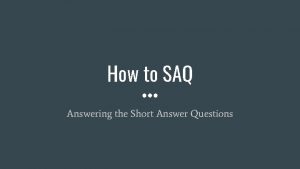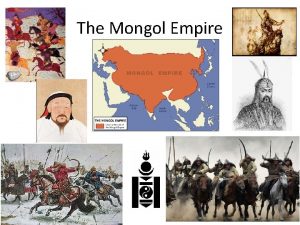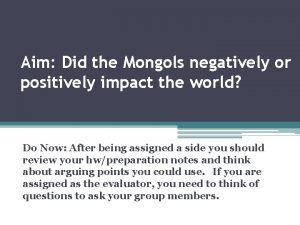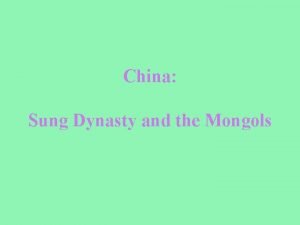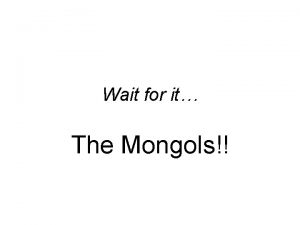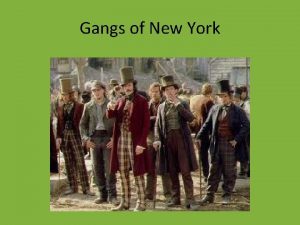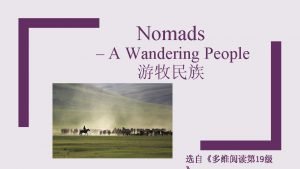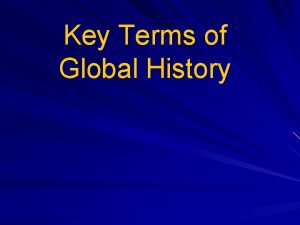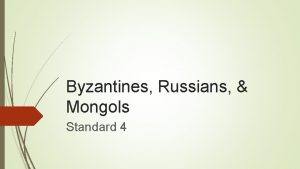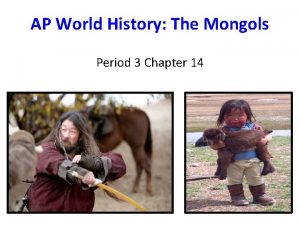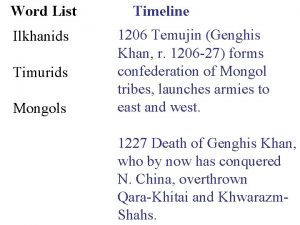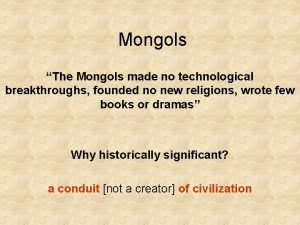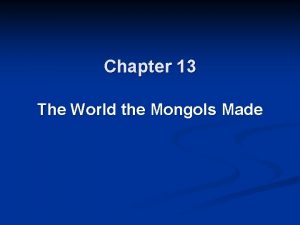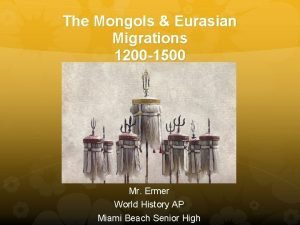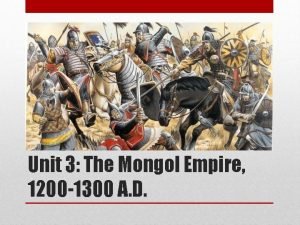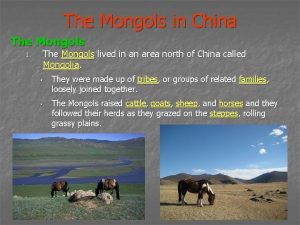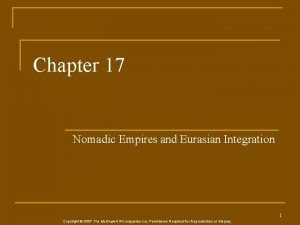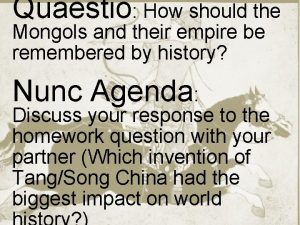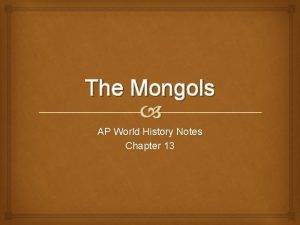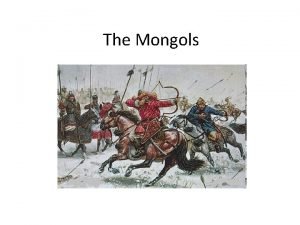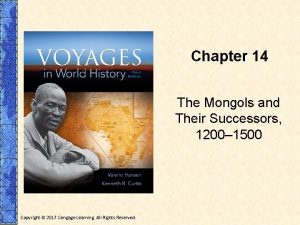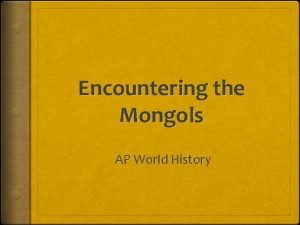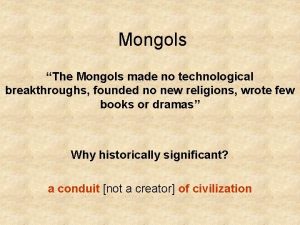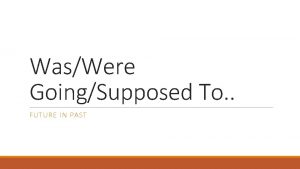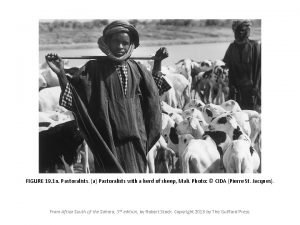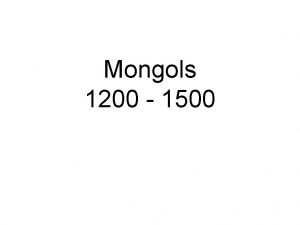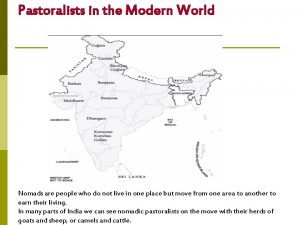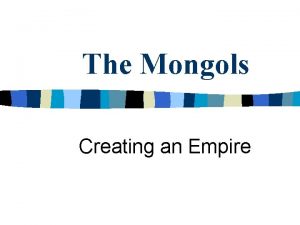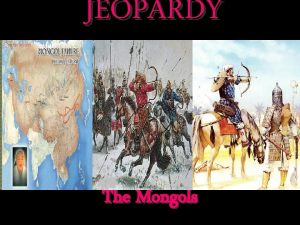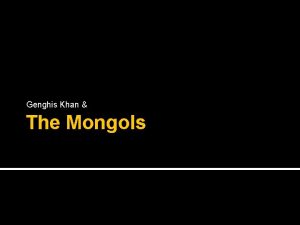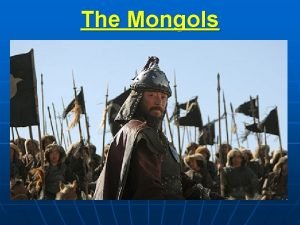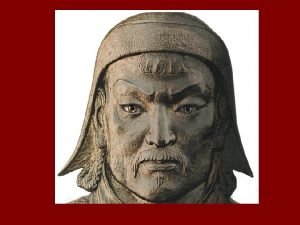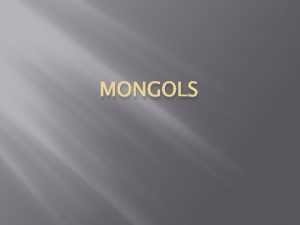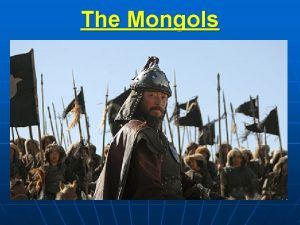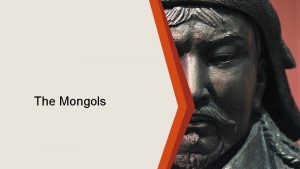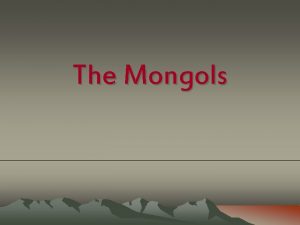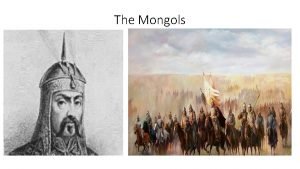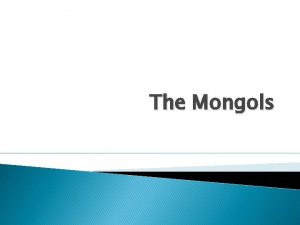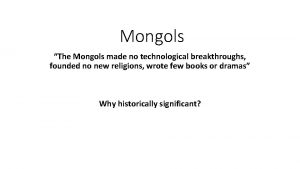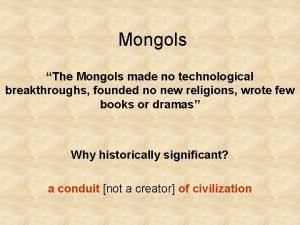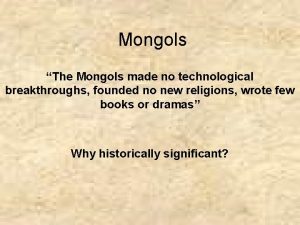The Mongols Who were the Mongols Nomads pastoralists









































- Slides: 41

The Mongols!

Who were the Mongols? Nomads, pastoralists: Xiongnu (Huns) Magyars Mongols ◦ Pastoralism, trade, raiding ◦ Self-sufficiency ◦ Plurality of religious practice Shamanism Buddhists, (Nestorian) Christians, Muslims Idea of a Great Khan

Mongol Conquests (1206 -1258) Temujin (TEH-moo-jeen) Declared himself: Genghis Khan (b. 1162; r. 1206 -1227) Really: Чингис Хаан, Chingis Khaan = “Ocean King” ◦ United Mongol tribes, “of all those who live in felt tents. ” ◦ Used Tengri - the Sky. God - to justify his rule

The wisdom of Chinggis Khan… “Man’s greatest joy is in victory: to conquer one’s enemies, to pursue them, to deprive them of their possessions, to make their beloved weep, to ride on their horses, and to embrace their wives and daughters…”

Why did they begin to expand? No one really knows few written records Booty? Climatic change? – Population high, temperatures fell, pastures decreased Population growth? Steppelanders being steppelanders?

Pre-Mongol Eurasia

Conquests by Chinggis’s death (1227)

Why were the Mongol armies so successful?

Why were the Mongol armies so successful? Simple, but effective All males, 15 -60, were eligible for conscription army was only source of honor Trained using massive hunts Great discipline Equipped for mobility and speed: lightly armored, no supply lines; couriers Careful planning, reconnaissance, intelligence Decimal system of organization: arbats (tens), zuuts (100 s), myanghan (1000 s), tumen (10, 000 s = roughly a division) Very good at adapting to various conditions. Became adept at siege warfare; recruited well; built effective catapults. Combined various types of armed force: mounted archers, lancers, engineers, rockets, and smoke.

Mongol Warfare Horsemen & archers ◦ Arrows deadly at 650+ ft Large, quick armies – up to 62 m/day Organized by 10 s (10, 1000) not by tribe Psychological warfare: ◦ Fake retreats ◦ Slaughter cities as example to others encourage surrender ◦ Biological warfare – Caffa & Plague

Key Conquests ◦ 1207 -1210: The Mongols made war against the Western Xia (northwestern China and parts of Tibet). ◦ Same period, the Uyghur Turks also submitted peacefully to the Mongols and became valued administrators throughout the empire. ◦ 1211: Chinggis Khan led his armies across the Gobi desert against the Jin Dynasty of northern China. ◦ 1219– 1221: While the campaign in northern China was still in progress, the Mongols waged a war in central Asia and destroyed the Khwarezmid Empire. ◦ 1223: The Mongols gained a decisive victory at the Battle of the Kalka River, the first engagement between the Mongols and the East Slavic warriors. ◦ 1227: Chinggis Khan died.


If you surrendered peacefully…generally treated ok

Ghengis Khan died in 1227 C. E. Mongol leaders returned to Karakorum, capital of Mongolia for a kuriltai. The empire at this point covered nearly 26 million sq. km. About four times the size of the Roman or Macedonian Empires.

Conquests by Chinggis’s death (1227)

Comparison: The Göktürk Khaganate ~600 CE

After Genghis - 1227 Son Ogedei to power EXPANSION! Succession fights & disruption 1259 – divide into autonomous khanates ◦ Golden Horde – Russia ◦ Ilkhanate – Middle East ◦ Chagatai – Central Mt Steppes ◦ Yuan Dynasty - China

Post-Chinggis conquests 1229: Ogedei elected as Great Khan. 1232: The siege of Kaifeng. Missile-rockets were used by Jurcheds for the first time in world history. 1236: Mongols conquered Jurched-Jin dynasty. 1236 -37: war against Song dynasty, but not completely conquered until 1270 s.

Post-Chinggis conquests 1237: Under the leadership of Batu Khan, the Mongols returned to the West and began their campaign to subjugate Kievan Rus’. 1240: Mongols sacked Kiev. 1241: mongols destroyed German, Magyar and Polish forces, and seemed unstoppable, but Ogodei khan’s death forced kuriltai; replaced by Mongke. 1258: Mongols occupied Baghdad. The fate of Abbasid caliphate. 1259: Mongol invasion of Syria. Mongke died. 1260: The battle of Ain Jalut: Mamluks defeated Mongols.

Mongol Empire at its height ~1290 CE

Giovanni da Pian del Carpini, 1246, at the enthroning of Guyuk Khan After many daies he called for vs againe, demanding whethere were any with our Lord the Pope, which vnderstood the Russian, the Saracen, or the Tartarian language? To whom we answered, that we had none of those letters or languages. …Then Kadac, principal agent for the whole empire, and Chingay, and Bala, with diuers other Scribes, came vnto vs, and interpreted the letter word for word. And hauing written it in Latine, they caused vs to interprete vnto them eche sentence, to wit if we had erred in any word. And when both letters were written, they made vs to reade them ouer twise more, least we should haue mistaken ought. For they said vnto vs: Take heed that ye vnderstand all things throughly, for if you should not vnderstand the whole matter aright, it might breed some inconuenience. They wrote the said letters also in the Saracen tongue that there might be some found in our dominions which could reade and interprete them, if need should require.

Giovanni da Pian del Carpini, 1246 Guyuk Khan’s reply to the pope: . . you must come yourself at the head of all your kings and prove to Us your fealty and allegiance. And if you disregard the command of God and disobey Our instructions, We shall look up on you as Our enemy. Whoever recognizes and submits to the Son of Gods and Lord of the World; whoever refuses submission will be wiped out. "

Rulers of the Mongol Empire 1206– 1227: Chinggis Khan 1227– 1241: Ogedei Khan 1246– 1248: Guyuk Khan 1251– 1259: Mongke Khan 1260– 1294: Khubilai Khan (Partially recognized)

Pax Mongolica Long Distance Trade b/c law & order on trade routes Encourage trade & exchange over empire Ex. Kublai visited by Marco Polo

Mongol rule and Mongol Peace Khanates (1299) Use of local elites (Persian merchant was the great Khan’s ambassador to the Mongol Il-khan in Persia. ) Tax farming Mongol rulers tended to focus on feasting, hunting, and internal disputes rather than day-to-day governing. Very flexible and tolerant: “But just as God has given different fingers to the hand, so He has given different religions to people. ”

Effects on Overland Trade Linked Christian, Muslim and Chinese worlds in one Pax Mongolica Encouraged Silk Road trade ◦ Patrols and passports ◦ Paid high prices at Karakorum and financed caravans Marco Polo (1253 -1324) ◦ Traveled with father and uncle to the East, made a fortune, and went back (1271 -1295) ◦ Great influence on European attitudes towards the East New Ideas from China went west: ◦ Paper and paper money, gunpowder, coal, movable type, passports, high-temperature furnaces, medicine, etc.

Marco Polo c. 1254 -1324 (aged 69)Venice, Italy

Yuan Dynasty in China, 1272 -1368 Kubilai Khan (b. 1214), ruled 1265 -1294 ◦ New capital at Dadu or Khanbalik (modern Beijing) ◦ Styled himself as a Chinese emperor. ◦ Introduced Mongols and Muslims into Chinese government. Mongol domination caused various effects in East Asia: ◦ Recentralization of China, trade, and government ◦ Prosperity in the cities, poverty in the countryside ◦ Extraction of wealth for benefit of Mongol khans

Il-Khan Empire Caused collapse of the Abbasid Caliphate. Hulegu Khan sacked Baghdad in 1258. 1295: Il-khan Ghazan adopted Islam; end of tolerance. Great deal of trade with China (silk roads) Ended 1343 with death of last Il-khan.

Mongol Conquests in Russia Fall of Kiev, 1240 “Mongol Yoke”? Batu (r. 1240 -1255) established “Golden Horde” rule ◦ Mongol capital at Sarai ◦ Taxes eventually farmed out to local princes. Rise of Novgorod and Moscow ◦ Alexander Nevskii (lived around 12201263) argued for cooperation with Mongols rather than resistance.

The limits of Mongol rule Mamluk Egypt Slaves into warriors In 1250 Mamluks rebelled by 1254 placed own ruler on the thrown. September 1260 at the Battle of Ain Jalut (Syria), Mamluks turned back Mongol armies. ◦ Mamluks were Turks and Circassians. ◦ Used midfa (hand cannon) ◦ Stopped Mongol expansion into Africa.

Invasion of Japan …FAIL! 2 attempts – 1274, 1281 Both times weather “saved” Japan – Typhoons Kamikaze “Divine Wind”

Dissolution of the Mongol Empire With the election of Kubilai Khan, the Empire started to show its cracks. Civil War broke out over the perceived illegitimacy of Kubilai, but there were other issues as well (such as a widening divide between the Eastern and Western Mongols, the latter who had converted to Islam). Kubilai won the Civil War and reunited the Empire, but it wasn’t to last. By the time Temur Khan took the throne in 1294, the Great Khan had little power and influence over the other Khans. The overthrow of the Yuan Dynasty in China in 1368 was the last death knell for any centralisation. The various Khans became fully independent, with the major powers being the Golden Horde, White Horde, Il. Khanate and Chagatai Khanate. These states would last for varying periods of time, but eventually they all fell to infighting themselves. The last of the Khanates would be conquered by Russia in the 17 th 18 th Centuries.

The nominally independent Khanates ~1300 CE

Mongols made no major technological breakthroughs, founded no religions, & left few books or art…So why important?

Mongol Empire’s Impact on Eurasia Movement of peoples, trade, ideas across Eurasia New innovations and ideas reached Europe (without the military devastation); increased European interest in the East, raised by works of Polo, Rubruck, and others. Brought new peoples to power: rise of Turkic dominance in the Muslim world (Ottomans, Delhi Sultanate, Mamluks), and new elites in the Slavic world. Created the first (and only) foreign dynasty in China. Opened the path for the plague.

The Mongols created a single economic, cultural, & epidemiological world system Trade & Exchange ◦ Venice to Beijing ◦ Cultural diffusion Methods of warfare Demographic shifts ◦ Population migrations ◦ Plague Alter histories of other states: Russia, China, Turkey

Comparison: Which of the following is NOT an attribute that pastoral societies generally exhibit in comparison to settled agricultural peoples? a. They generally offer women a lower status with no roles at all in public life. b. They are far more mobile. c. They live in smaller more widely scattered groups. d. They rely more heavily on their animals.

Discussion Question: Do you think that the modern image of Mongols a. is warranted given their history? b. is partially warranted given their history? c. is misleading because they were little different from other pastoralists in world history? d. is the product of the peoples that they conquered writing their history?

Discussion Question: For you, which of the following was the most important contribution of the Mongol Empire to world history? a. They constructed the largest Eurasian empire to date. b. They destroyed a series of well-established empires. c. They fostered trade, the spread of disease, and the exchange of crops and technology across Eurasia. d. The disruption of trade caused by the collapse of their empire provided an important incentive for Europeans to take to the seas in an effort to secure sought-after Asian goods.

Discussion Question: Regarded as a whole, was the Mongol impact on world history more positive or negative? a. The Mongol impact on world history was more positive than negative. b. The Mongol impact on world history was more negative than positive.
 Saq examples
Saq examples Genghis real name
Genghis real name How did the mongols positively impact the world
How did the mongols positively impact the world Sung dynasty art
Sung dynasty art Wait for it the mongols
Wait for it the mongols Savage nomads mc
Savage nomads mc Nomads are wandering people
Nomads are wandering people Nomads
Nomads Having to do with worldly, rather than religious matters
Having to do with worldly, rather than religious matters The mongols in world history webquest
The mongols in world history webquest Byzantines vs mongols
Byzantines vs mongols Mongols vs vikings
Mongols vs vikings The mongols in world history
The mongols in world history Timurid tile
Timurid tile Mongolian diet meme
Mongolian diet meme Encountering the mongols comparing three cases
Encountering the mongols comparing three cases Mongols chapter 13
Mongols chapter 13 Golden horde ap world history
Golden horde ap world history Mongols miami
Mongols miami The mongol empire spans eurasia worksheet answer key
The mongol empire spans eurasia worksheet answer key The mongols lived in an area north of china called
The mongols lived in an area north of china called Tughril
Tughril How should the mongols be remembered
How should the mongols be remembered Wait for it the mongols
Wait for it the mongols Ap world history chapter 13 notes
Ap world history chapter 13 notes Mongols background
Mongols background Cengage
Cengage Mongols in russia ap world history
Mongols in russia ap world history The mongols made no technological breakthroughs
The mongols made no technological breakthroughs Was/were going to
Was/were going to Phối cảnh
Phối cảnh Một số thể thơ truyền thống
Một số thể thơ truyền thống Thế nào là hệ số cao nhất
Thế nào là hệ số cao nhất Hệ hô hấp
Hệ hô hấp Slidetodoc
Slidetodoc Số nguyên tố là gì
Số nguyên tố là gì Tư thế ngồi viết
Tư thế ngồi viết đặc điểm cơ thể của người tối cổ
đặc điểm cơ thể của người tối cổ Cách giải mật thư tọa độ
Cách giải mật thư tọa độ Các châu lục và đại dương trên thế giới
Các châu lục và đại dương trên thế giới Chụp tư thế worms-breton
Chụp tư thế worms-breton ưu thế lai là gì
ưu thế lai là gì
